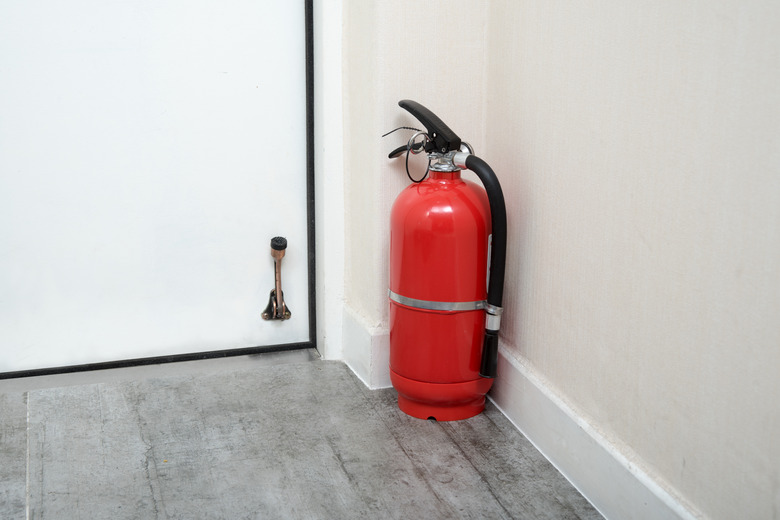Can You Store Fire Extinguishers Outside In Freezing Temperatures?
We may receive a commission on purchases made from links.
If you're going to have one or more fire extinguishers around your home, you'll want them easily accessible, and you'll need them to function properly when you pull the pin, aim the nozzle, and squeeze the lever. These require smart decisions about both location and proper storage. You can store your fire extinguisher outside in freezing temperatures, but it's not always a good idea.
Tip
If it's necessary to do so, you can keep fire extinguishers in freezing temperatures, but when the temperature is below -40 degrees Fahrenheit, some will freeze, and others can malfunction and suffer from shorter life.
Fire Extinguisher Storage Temperatures
Fire Extinguisher Storage Temperatures
Fire extinguishers should be stored at temperatures between -40 degrees and 120 degrees Fahrenheit to ensure proper functioning. Storing your fire extinguisher at temperatures below -40 degrees can cause cracked hoses and valves, and depending on the type of extinguisher, freezing can occur. The relatively new water-mist extinguishers, the water-using Class A fire extinguishers, Class K extinguishers, and those using AFFF foam and FFFP foam will freeze in temperatures below -40 degrees.
The standard fire extinguisher for home use — the dry-chemical ABC unit — pushes the envelope somewhat. It's able to handle low storage temperatures down to -65 degrees. Others faring better in the cold are those using pressurized water with antifreeze, halon, halotron, and CO2 as well as class D and other dry-chemical extinguishers.
At the other end, high temperatures can also hurt fire extinguishers. Those stored at temperatures exceeding 120 degrees will have a shorter life span. The elastomeric seals will deteriorate, and discharge times can be shortened.
Storing Your Fire Extinguisher
Storing Your Fire Extinguisher
Fire extinguishers should be readily accessible and available. They should be mounted with appropriate brackets and placed where there are no obstructions so you can grab them quickly. They should be near areas that are prone to fire hazards, such as kitchens. So, if you're thinking of stashing one in a garage or basement just to keep it out of your way, give that a second thought.
Elevation is also important for convenient access. The bottom of the extinguisher should be at least 4 inches off the ground and the top not more than 5 feet from the ground. Fire extinguishers can be stored horizontally if necessary and can also be stored in automobiles if the average temperature within the vehicle falls within the UL rating, which is usually -40 degrees to 120 degrees.
Fire Extinguisher Classes
Fire Extinguisher Classes
When you start looking into purchasing a fire extinguisher, things can get a bit confusing. That's because there are different types and classes of extinguishers — classes A, B, C, D, and K — with the letter or letters showing on the unit indicating the class of fire for which it's used. Not all of them work on all five classes of fires, and when used on fires for which they're not intended, they can be dangerous. Knowing which type of extinguisher to buy and use in and around your home is extremely important.
- Class A fires: Combustible solid materials, like paper or wood, that are burning
freely.
- Class B fires: Flammable liquids, like gasoline, oils,
solvents, petroleum greases, alcohols, and oil-based paints. Flammable
gases, such as propane, butane, and hydrogen.
- Class C fires: These fires involve an electrical component — like an appliance or wiring — that is
connected to an electrical source.
- Class D fires: Burning metals, usually in warehouses, labs, and
factories where metals are used for manufacturing.
- Class K fires: High-temperature cooking oil and grease fires most often in commercial kitchens.
A clear example of the importance of using the correct class of extinguisher involves Class C extinguishers and Class C fires, which can result from things like short circuits, faulty wiring, overcharged devices, and overloaded outlets. Even though Class C extinguishers don't conduct electricity, disconnecting the power source before fighting the fire is still best if possible. As long as the power remains on, it continues igniting the fire no matter what you do, creating a hazard. If you're using the wrong extinguisher — which in this case would be a water-based Class A extinguisher — there's a risk for electrocution.
References
- National Fire Protection Association: Fire Extinguisher Types
- National Fire Protection Association: NFPA 1: Location and Placement Requirements for Portable Fire Extinguishers
- Koorsen Fire & Security: What Are the Different Types of Fire Extinguishers & Their Uses?
- Koorsen Fire & Security: What Is a Class A Fire Extinguisher Used For?
- Koorsen Fire and Security: What Is a Class C Fire Extinguisher Used For?
- Fire Control Systems: Class D Fires Explained
- Koorsen Fire & Security: What Is a Class K Fire Extinguisher Used For?
- Kidde Fire Safety: At What Temperature Should I Store My Fire Extinguishers?
- First Alert: Fire Extinguishers: Frequently Asked Questions
- West Chester University: Fire Extinguisher 101
- All Fire Services: What Are the Best Temperatures for Storing a Fire Extinguisher?
